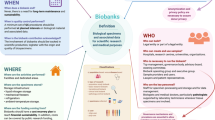Abstract
Purpose
To report experience designing and establishing a reproductive registry and sample biorepository and to describe initial subject characteristics and biospecimens.
Methods
Beginning in December 2017, patients presenting for reproductive care at the University of Michigan were approached for study enrollment. Following consent, subjects completed detailed reproductive and health questionnaires. A variety of reproductive specimens and tissues were collected and processed for multiple downstream applications.
Results
Subject enrollment began in December of 2017. There are currently 1798 subjects enrolled. Female participants report a variety of reproductive disorders. Available samples include semen, sperm, follicular fluid, granulosa cells, immature oocytes, ovarian and uterine tissue, and blood samples.
Conclusion
We report the successful establishment of a reproductive registry and sample biorepository. Furthermore, we describe methods for collection and storage of a variety of reproductive tissue processed for multiple downstream translational applications.


Similar content being viewed by others
References
Collins FS, Varmus H. A new initiative on precision medicine. N Engl J Med. 2015;372(9):793–5.
NIH. The Promise of Precision Medicine. 2020; Available from: https://www.nih.gov/about-nih/what-we-do/nih-turning-discovery-into-health/promise-precision-medicine.
De Souza YG, Greenspan JS. Biobanking past, present and future: responsibilities and benefits. AIDS. 2013;27(3):303–12.
Vaught J. Biobanking comes of age: the transition to biospecimen science. Annu Rev Pharmacol Toxicol. 2016;56:211–28.
Carrick DM, Mette E, Hoyle B, Rogers SD, Gillanders EM, Schully SD, et al. The use of biospecimens in population-based research: a review of the National Cancer Institute's Division of Cancer Control and Population Sciences grant portfolio. Biopreserv Biobank. 2014;12(4):240–5.
Palmer LJ. UK Biobank: bank on it. Lancet. 2007;369(9578):1980–2.
Kaiser Permanente Research Bank. Available from: https://researchbank.kaiserpermanente.org/.
All of Us Research Program, I., et al., The "All of Us" Research Program. N Engl J Med, 2019. 381(7): p. 668-676.
University of Michigan Central Biorepository. Available from: https://research.medicine.umich.edu/our-units/central-biorepository.
Schenk M, Huppertz B, Obermayer-Pietsch B, Kastelic D, Hörmann-Kröpfl M, Weiss G. Biobanking of different body fluids within the frame of IVF-a standard operating procedure to improve reproductive biology research. J Assist Reprod Genet. 2017;34(2):283–90.
Santillan MK, Leslie KK, Hamilton WS, Boese BJ, Ahuja M, Hunter SK, et al. Collection of a lifetime: a practical approach to developing a longitudinal collection of women's healthcare biological samples. Eur J Obstet Gynecol Reprod Biol. 2014;179:94–9.
Krawetz SA, Casson PR, Diamond MP, Zhang H, Legro RS, Schlaff WD, et al. Establishing a biologic specimens repository for reproductive clinical trials: technical aspects. Syst Biol Reprod Med. 2011;57(5):222–7.
Ruth KS, Perry JRB, Henley WE, Melzer D, Weedon MN, Murray A. Events in early life are associated with female reproductive ageing: a UK Biobank Study. Sci Rep. 2016;6:24710.
Sheldon E, et al. Biobanking human endometrial tissue and blood specimens: standard operating procedure and importance to reproductive biology research and diagnostic development. Fertil Steril. 2011;95(6):2120–2 2122 e1-12.
Capps B. Models of biobanks and implications for reproductive health innovation. Monash Bioeth Rev. 2015;33(4):238–57.
Gelbaya TA, Potdar N, Jeve YB, Nardo LG. Definition and epidemiology of unexplained infertility. Obstet Gynecol Surv. 2014;69(2):109–15.
Harris PA, et al. The REDCap consortium: Building an international community of software platform partners. J Biomed Inform. 2019;95:103208.
Harris PA, Taylor R, Thielke R, Payne J, Gonzalez N, Conde JG. Research electronic data capture (REDCap)--a metadata-driven methodology and workflow process for providing translational research informatics support. J Biomed Inform. 2009;42(2):377–81.
Cooper TG, Noonan E, von Eckardstein S, Auger J, Baker HWG, Behre HM, et al. World Health Organization reference values for human semen characteristics. Hum Reprod Update. 2010;16(3):231–45.
Marsh EE, Steinberg ML, Parker JB, Wu J, Chakravarti D, Bulun SE. Decreased expression of microRNA-29 family in leiomyoma contributes to increased major fibrillar collagen production. Fertil Steril. 2016;106(3):766–72.
Marsh EE, Chibber S, Wu J, Siegersma K, Kim J, Bulun S. Epidermal growth factor-containing fibulin-like extracellular matrix protein 1 expression and regulation in uterine leiomyoma. Fertil Steril. 2016;105(4):1070–5.
Murphy AR, et al. Generation of multicellular human primary endometrial organoids. J Vis Exp. 2019;152.
Zhang PY, Yu Y. Precise personalized medicine in gynecology cancer and infertility. Front Cell Dev Biol. 2019;7:382.
Jungwirth A, Giwercman A, Tournaye H, Diemer T, Kopa Z, Dohle G, et al. European Association of Urology guidelines on Male Infertility: the 2012 update. Eur Urol. 2012;62(2):324–32.
Sunderam S, Kissin DM, Zhang Y, Folger SG, Boulet SL, Warner L, et al. Assisted reproductive technology surveillance - United States, 2016. MMWR Surveill Summ. 2019;68(4):1–23.
Jain T, Grainger DA, Ball GD, Gibbons WE, Rebar RW, Robins JC, et al. 30 years of data: impact of the United States in vitro fertilization data registry on advancing fertility care. Fertil Steril. 2019;111(3):477–88.
Wu AK, Odisho AY, Washington SL, Katz PP, Smith JF. Out-of-pocket fertility patient expense: data from a multicenter prospective infertility cohort. J Urol. 2014;191(2):427–32.
Funding
This work was supported by the University of Michigan Department of Obstetrics & Gynecology. This work was also funded by the National Institutes of Health Grants 5K12HD065257-10 (DF & SBS), 5R01HD088638-03(EEM) & 5R01MD011570-05(EEM).
Author information
Authors and Affiliations
Corresponding author
Ethics declarations
Ethics approval
The protocols and procedures reported have been approved by the Institutional Review Board of the University of Michigan Medical School (IRBMED), registered under ID HUM00125627.
Conflict of interest
EEM is a consultant for Myovant Sciences. The other authors declare that they have no conflicts of interest.
Additional information
Publisher’s note
Springer Nature remains neutral with regard to jurisdictional claims in published maps and institutional affiliations.
Rights and permissions
About this article
Cite this article
Schon, S.B., Raja, N., Xu, M. et al. Establishing a reproductive biorepository for basic and translational research: experience developing the reproductive subjects registry and sample repository. J Assist Reprod Genet 38, 2097–2105 (2021). https://doi.org/10.1007/s10815-021-02165-6
Received:
Accepted:
Published:
Issue Date:
DOI: https://doi.org/10.1007/s10815-021-02165-6




